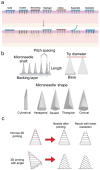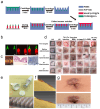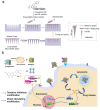Leveraging Microneedles for Raised Scar Management
- PMID: 39795511
- PMCID: PMC11722619
- DOI: 10.3390/polym17010108
Leveraging Microneedles for Raised Scar Management
Abstract
Disruption of the molecular pathways during physiological wound healing can lead to raised scar formation, characterized by rigid, thick scar tissue with associated symptoms of pain and pruritus. A key mechanical factor in raised scar development is excessive tension at the wound site. Recently, microneedles (MNs) have emerged as promising tools for scar management as they engage with scar tissue and provide them with mechanical off-loading from both internal and external sources. This review explores the mechanisms by which physical intervention of drug-free MNs alleviates mechanical tension on fibroblasts within scar tissue, thereby promoting tissue remodeling and reducing scar severity. Additionally, the role of MNs as an efficient cargo delivery system for the controlled and sustained release of a wide range of therapeutic agents into scar tissue is highlighted. By penetrating scar tissue, MNs facilitate controlled and sustained localized drug administration to modulate inflammation and fibroblastic cell growth. Finally, the remaining challenges and the future perspective of the field have been highlighted.
Keywords: drug delivery; hydrogels; hypertrophic scar; keloids; microneedle.
Conflict of interest statement
The authors declare no conflict of interest.
Figures






Similar articles
-
Down-Regulating Scar Formation by Microneedles Directly via a Mechanical Communication Pathway.ACS Nano. 2022 Jul 26;16(7):10163-10178. doi: 10.1021/acsnano.1c11016. Epub 2022 May 26. ACS Nano. 2022. PMID: 35617518 Free PMC article.
-
Metal-organic framework microneedles for precision transdermal drug delivery: design strategy and therapeutic potential.Nanoscale. 2025 Mar 7;17(10):5571-5604. doi: 10.1039/d4nr03898c. Nanoscale. 2025. PMID: 39918280 Review.
-
Therapeutic Potential of Microneedle Assisted Drug Delivery for Wound Healing: Current State of the Art, Challenges, and Future Perspective.AAPS PharmSciTech. 2025 Jan 8;26(1):25. doi: 10.1208/s12249-024-03017-z. AAPS PharmSciTech. 2025. PMID: 39779610 Review.
-
Tension-sensitive HOX gene expression in fibroblasts for differential scar formation.J Transl Med. 2025 Feb 10;23(1):168. doi: 10.1186/s12967-025-06191-1. J Transl Med. 2025. PMID: 39930512 Free PMC article.
-
Endothelial dysfunction may play a key role in keloid and hypertrophic scar pathogenesis - Keloids and hypertrophic scars may be vascular disorders.Med Hypotheses. 2016 Nov;96:51-60. doi: 10.1016/j.mehy.2016.09.024. Epub 2016 Sep 28. Med Hypotheses. 2016. PMID: 27959277
Cited by
-
Exosome-Loaded GelMA Hydrogel as a Cell-Free Therapeutic Strategy for Hypertrophic Scar Inhibition.Clin Cosmet Investig Dermatol. 2025 May 6;18:1137-1149. doi: 10.2147/CCID.S520913. eCollection 2025. Clin Cosmet Investig Dermatol. 2025. PMID: 40351852 Free PMC article.
References
Publication types
Grants and funding
LinkOut - more resources
Full Text Sources

